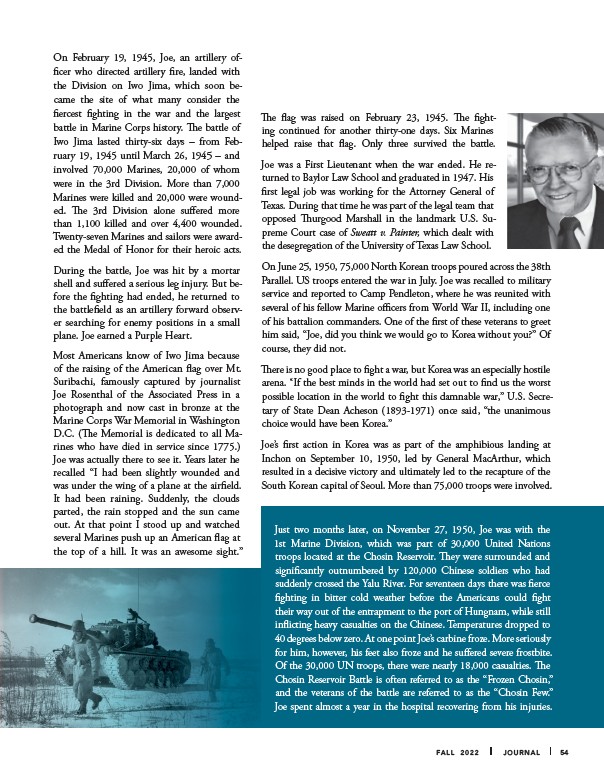
The flag was raised on February 23, 1945. The fighting
continued for another thirty-one days. Six Marines
helped raise that flag. Only three survived the battle.
Joe was a First Lieutenant when the war ended. He returned
to Baylor Law School and graduated in 1947. His
first legal job was working for the Attorney General of
Texas. During that time he was part of the legal team that
opposed Thurgood Marshall in the landmark U.S. Supreme
Court case of Sweatt v. Painter, which dealt with
the desegregation of the University of Texas Law School.
On June 25, 1950, 75,000 North Korean troops poured across the 38th
Parallel. US troops entered the war in July. Joe was recalled to military
service and reported to Camp Pendleton, where he was reunited with
several of his fellow Marine officers from World War II, including one
of his battalion commanders. One of the first of these veterans to greet
him said, “Joe, did you think we would go to Korea without you?” Of
course, they did not.
There is no good place to fight a war, but Korea was an especially hostile
arena. “If the best minds in the world had set out to find us the worst
possible location in the world to fight this damnable war,” U.S. Secretary
of State Dean Acheson (1893-1971) once said, “the unanimous
choice would have been Korea.”
Joe’s first action in Korea was as part of the amphibious landing at
Inchon on September 10, 1950, led by General MacArthur, which
resulted in a decisive victory and ultimately led to the recapture of the
South Korean capital of Seoul. More than 75,000 troops were involved.
Just two months later, on November 27, 1950, Joe was with the
1st Marine Division, which was part of 30,000 United Nations
troops located at the Chosin Reservoir. They were surrounded and
significantly outnumbered by 120,000 Chinese soldiers who had
suddenly crossed the Yalu River. For seventeen days there was fierce
fighting in bitter cold weather before the Americans could fight
their way out of the entrapment to the port of Hungnam, while still
inflicting heavy casualties on the Chinese. Temperatures dropped to
40 degrees below zero. At one point Joe’s carbine froze. More seriously
for him, however, his feet also froze and he suffered severe frostbite.
Of the 30,000 UN troops, there were nearly 18,000 casualties. The
Chosin Reservoir Battle is often referred to as the “Frozen Chosin,”
and the veterans of the battle are referred to as the “Chosin Few.”
Joe spent almost a year in the hospital recovering from his injuries.
On February 19, 1945, Joe, an artillery officer
who directed artillery fire, landed with
the Division on Iwo Jima, which soon became
the site of what many consider the
fiercest fighting in the war and the largest
battle in Marine Corps history. The battle of
Iwo Jima lasted thirty-six days – from February
19, 1945 until March 26, 1945 – and
involved 70,000 Marines, 20,000 of whom
were in the 3rd Division. More than 7,000
Marines were killed and 20,000 were wounded.
The 3rd Division alone suffered more
than 1,100 killed and over 4,400 wounded.
Twenty-seven Marines and sailors were awarded
the Medal of Honor for their heroic acts.
During the battle, Joe was hit by a mortar
shell and suffered a serious leg injury. But before
the fighting had ended, he returned to
the battlefield as an artillery forward observer
searching for enemy positions in a small
plane. Joe earned a Purple Heart.
Most Americans know of Iwo Jima because
of the raising of the American flag over Mt.
Suribachi, famously captured by journalist
Joe Rosenthal of the Associated Press in a
photograph and now cast in bronze at the
Marine Corps War Memorial in Washington
D.C. (The Memorial is dedicated to all Marines
who have died in service since 1775.)
Joe was actually there to see it. Years later he
recalled “I had been slightly wounded and
was under the wing of a plane at the airfield.
It had been raining. Suddenly, the clouds
parted, the rain stopped and the sun came
out. At that point I stood up and watched
several Marines push up an American flag at
the top of a hill. It was an awesome sight.”
FALL 2022 JOURNAL 54